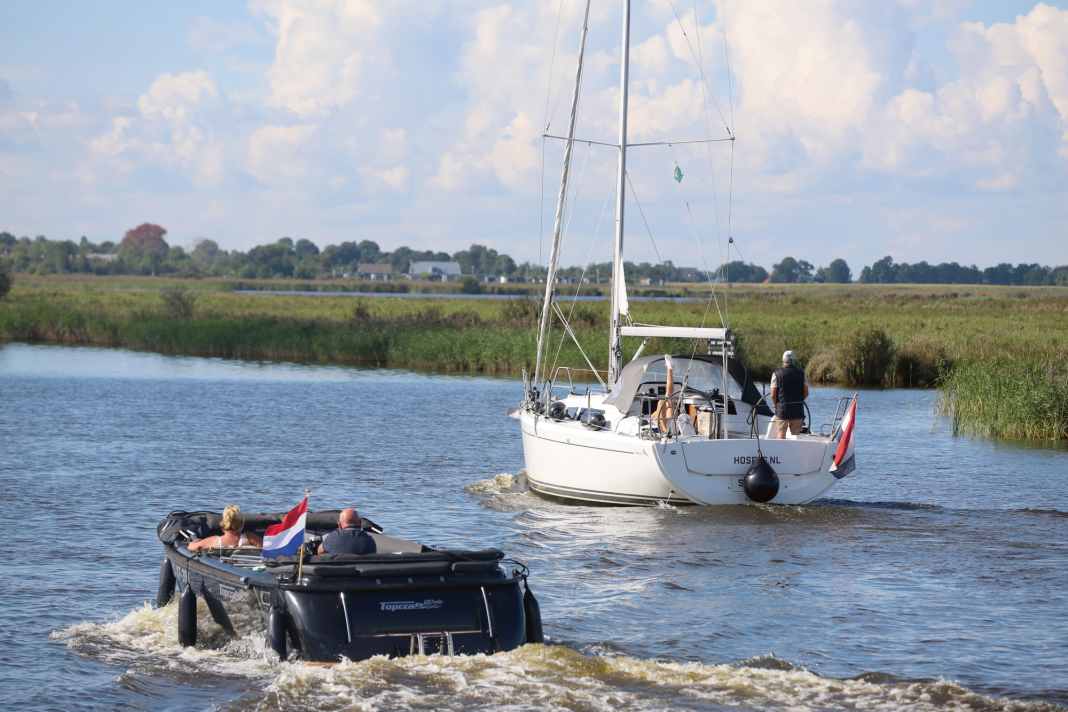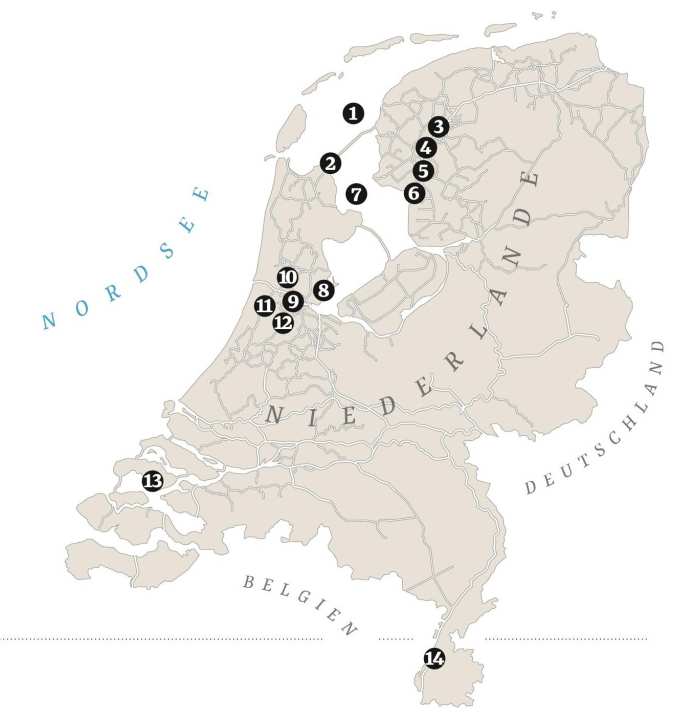Construction sites, bridges and footbridges: What's happening in the Netherlands






- 1st Boontjes (Waddenzee)
- 2 Den Oever
- 3. grou
- 4. uitwellingerga
- 5th Oude Schouw/ Spannenburg
- 6th Lemmer
- 7th De Kreupel (IJsselmeer)
- 8th Uitdam
- 9. Amsterdam
- 10th Zaandam
- 11 Haarlem
- 12th Schiphol
- 13th province of Zeeland
- 14th Province of Limburg
- Service: nautical charts, GPS errors, stewards at locks
- GPS error
One after the other: It is clear that the outlet valves of the toilet system on board will have to be sealed from 2026. According to reports, this will be done using numbered cable ties, which must be indicated as being in use in an app or on a website. If the specified cable tie is missing during an on-board inspection, a fine may be imposed.
However, many details are still unclear: the discharge ban only applies to faeces, but urine may still be discharged. In addition, extraction facilities are to be operational in the harbours by 2026. So-called purification facilities, the use of which would make the discharge legal again, are currently only available in pre-series versions and at hefty prices. So this issue remains exciting. However, the responsible authorities have promised clear regulations until the introduction. We will be following developments.
The infrastructure also continues to pose challenges: A great need for renovation has recently become apparent here. While some bridges and locks have already been renovated, others have had to cease operations, such as recently in Uitwellingerga in Friesland. Water sports enthusiasts will have to come to terms with these restrictions in the Netherlands over the next few years. Nevertheless, our neighbours have recognised the need and are tackling the issue head-on.
1st Boontjes (Waddenzee)
The Boontjes fairway between Kornwerderzand and Harlingen was recently kept at NAP-3.80 metres. This caused a lot of effort and stirred up sediment. Now they want to go to NAP-3.30 metres on a trial basis. At LAT, this means a water depth of around 1.96 metres.
2 Den Oever
The dyke was renovated, reinforced and made future-proof. A gigantic pumping station was put into operation in Den Oever, which can pump water out of the IJsselmeer at high capacity, even against high water levels on the mudflats: an Olympic-sized swimming pool full - every eight seconds. A fish migration river is also being created on the other side of the dyke, in which salmon in particular will swim from the salt water into the IJsselmeer and on into the rivers flowing into it. The project will be completed in 2026.
3. grou
Two cult pubs, the Bierhalle and Treemter, are closing in the Frisian town. The Bierhalle was traditionally the place to go for chilly water sports enthusiasts. Unfortunately, the cosy pub has not found a successor operator. Now it is being turned into flats. The Treemter discotheque building, on the other hand, is to house a library in future.
4. uitwellingerga
The bascule bridge on the Prinses Margrietkanaal is dilapidated and permanently closed. It can no longer be used by road traffic or opened for shipping. Rijkswaterstaat will not remove the damaged bascule bridge until next year. The bridge will then remain permanently open to water sports enthusiasts for the time being. A replacement structure is already being planned and work on it is scheduled for completion in 2029.
5th Oude Schouw/ Spannenburg
Two other bridges along the Prinses Margrietkanaal are just as old as the one in Uitwellingerga. The Hague has now realised that it would be better to hurry up with the new construction before there are also failures there. Necessary renovation work will therefore also soon be carried out on these two bridges.
6th Lemmer
The popular little pedestrian harbour on the IJsselmeer side of the old lock is permanently closed and no longer accessible to guests. An investor has acquired the harbour and set up areas for residential boats, which are rented out on a long-term basis.
7th De Kreupel (IJsselmeer)
The jetties and moorings on the island off Andijk in the IJsselmeer have been badly damaged by various storms in recent years. They have now been repaired and the island is once again open to visitors. However, the jetties are due to be completely renovated from 2026.
8th Uitdam
The port operators from neighbouring Monnickendam are expanding their services and are now also looking after the port of Uitdam. It belongs to a bungalow park, but the owners had no interest in the harbour, which clearly shows its condition. That is set to change. Uitdam is ideal for families and is also the perfect jumping-off point for a trip to Amsterdam.
9. Amsterdam
There are three current issues in the metropolis. Firstly, the night crossing: the Oranjesluizen are only open to pleasure craft from 15 minutes before sunrise to 15 minutes after sunset. If you want to cross the city in between, you will no longer be able to continue towards the Markermeer.
The second is the construction of the new bridge over the IJ: after a long discussion, it's a done deal - the bridge is definitely coming. Planning will begin and construction will start in 2031. Sailors will have to be prepared for waiting times when passing through, as the bridge will certainly not be opened too often.
Closed canals: The city's canal belt may no longer be navigated by boats with combustion engines. There is one temporary exception: Anyone with a waterway licence may still use it until the end of its validity. Passage on the IJ or on the Kostverlorenvaart, which is part of the Staande Mastroute, is exempt. For the Kostverlorenvaart, however, this exemption could end in 2030.
10th Zaandam
The Coenbrug in Zaandam was closed for a long time. Now the decision has been made to repair the bridge after all. It should be ready in May, when the passage to the Zaanse Schans Museum and the Noordhollandsch Kanaal will be open again, even for boats with a clearance height of more than 6.20 metres.
11 Haarlem
The passage on the Zijkanaal C through Haarlem, the alternative route to the Staande Mastroute through Amsterdam, is still not free. The Buitenhuizerbrug, south of the mouth of the Noordzeekanaal, is out of order. It is not yet clear for how long. The water sports organisations are up in arms, but Rijkswaterstaat cannot yet give a concrete date for a repair.
12th Schiphol
The important Schiphol Bridge to the south of Amsterdam was rebuilt, but broke down again during the trial run. It is still completely unclear what will happen there now. It is also unclear how long the movable bridge can only be passed when closed.
13th province of Zeeland
Here, the important access locks to the Grevelingen (Grevelingensluis) and the Veerse Meer (Zandkreeksluis) were renovated and the waiting areas on both sides of the structures were renewed. The lock to the Veerse Meer had recently sagged on the outside. This was stopped with massive concrete fillings in the subsoil. If the measures are not sufficient, there is a risk of long closures. On the Oosterschelde, the Zeelandbrug crossing will definitely only be opened once an hour after a test phase. This should reduce dangerous road traffic situations on the bridge. The waiting time of the yachts on the flowing water below was not taken into account.
14th Province of Limburg
Roermond is set for major construction. Flat blocks with their own moorings are being built between Steelhaven and Roer. Some of the existing harbour areas will have to make way. The widening of the Julianakanaal near Born has been completed and the canal bed has been filled with water again. A four-kilometre stretch of the canal had been drained since August. The work was completed four days ahead of schedule. Yachts will be able to pass through the canal again from May. Lock 13 on the Zuid-Willemsvaart is still closed until 1 June.
Service: nautical charts, GPS errors, stewards at locks
Sea charts
The 1801 map for the entire North Sea coast will be discontinued. There will also be no more corrections from October. The same applies to the British maps from Imray. Only NV Charts still offers paper charts for the sea area.

GPS error
The Watersportverbond warns of possible GPS interference in the Netherlands. This is particularly relevant in the North Sea, as there are restricted areas in the vicinity of wind farms, for example, which must be observed at all times. Terrestrial navigation is therefore particularly important there.
Stewards at locks
Rijkswaterstaat once again deploys stewards on busy locks in the summer to facilitate the process. They organise a quick and sensible use of the chamber. Unfortunately, they do not take care of those pushing in front. When stewards are on duty, this is indicated in front of the lock.

